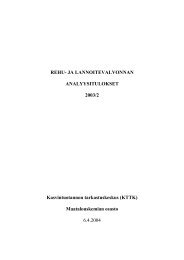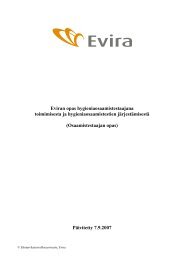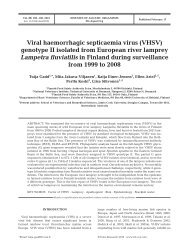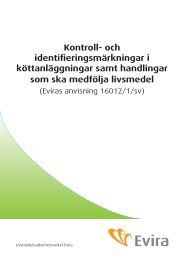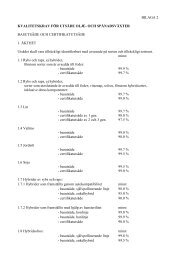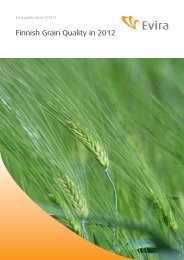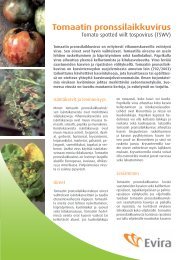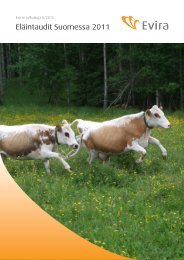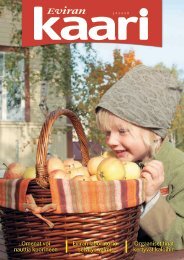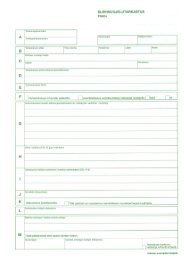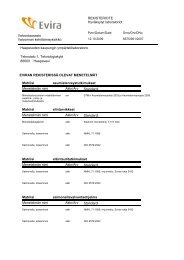Download PDF, 1522 kB - Evira
Download PDF, 1522 kB - Evira
Download PDF, 1522 kB - Evira
You also want an ePaper? Increase the reach of your titles
YUMPU automatically turns print PDFs into web optimized ePapers that Google loves.
4 Salmonella control of feedstuffs<br />
Kaija Varimo, director, <strong>Evira</strong><br />
4.1 Legislation<br />
For over forty years already, inspections have been carried out in Finland for<br />
Salmonella in feedstuffs according to the Feed Act. In 1995 - 2004, both the<br />
Feed Act and the Animal Diseases Act were applied to imports of feeds of animal<br />
origin and to the production and control of certain feeds of animal origin. Hygiene<br />
requirements for feedstuffs has been complemented by national legislation<br />
more extensively than by EU regulations, e.g., regarding feedstuffs of vegetable<br />
origin. Official inspection has controlled each batch of imported raw materials of<br />
vegetable origin presenting Salmonella risks. The EU regulation on by-products<br />
of animal origin applied since 2003 has covered the handling, use and control of<br />
by-products being forwarded for use in feedstuffs as well as other purposes.<br />
Annually, 1.20 - 1.49 million tons of feed mixtures has been produced in Finland.<br />
This trend in production amounts has been slowly growing. Raw materials carefully<br />
controlled for Salmonella by authorities as also partly by operational parties<br />
create prerequisites for the manufacture of products of good hygienic quality.<br />
Feed manufacturers have self-control systems based on the HACCP principle<br />
to eliminate pathogens from feed-manufacturing processes. Authorities control<br />
the production of raw materials as well as compound feeds by taking samples<br />
of final products, and by controlling the company’s self-control. Manufacturers<br />
themselves take samples of the processes and in the production facilities in<br />
accordance with self-control plans that have been verified by the authorities. As<br />
feed mixtures are generally delivered as bulk feeds directly to farms, the Salmonella<br />
risks must already be eliminated in raw materials before manufacturing and<br />
from all the stages of manufacture. Final products are inspected for Salmonella<br />
by random sampling. However, the authority will always increase the frequency<br />
of manufacturing control when hygiene problems occur.<br />
The authority sets marketing prohibitions for feed batches contaminated by<br />
Salmonella. If the owners of the raw material of feedstuffs choose to process<br />
the feed to destroy Salmonella (heating or acidation), they must apply to the<br />
authority for a permit for the procedure. If after processing and repeated analysis<br />
for Salmonella, the batch is found clean, it is released for use as feedstuff. If feed<br />
mixtures are found to contain Salmonella they are not processed but destroyed,<br />
and the factory’s contaminated manufacturing line is closed down for disinfection.<br />
The cause of contamination is investigated, the feeds are traced to farms and<br />
markets, and if necessary, the facilities are disinfected from Salmonella under<br />
supervision by municipal veterinarians.<br />
4.2 Sampling<br />
The Finnish Food Safety Authority <strong>Evira</strong> regularly inspects manufacturers of<br />
feedstuffs, feed mixtures and feed additives. Samples are taken of feed products<br />
imported, being produced and in markets for analysis in accordance with annual<br />
control plans. <strong>Evira</strong> has authorized and trained about one hundred part-time<br />
samplers who collect samples for official control. The frequency of sampling and<br />
analysis is decided by the respective Salmonella risks as estimated for each<br />
feed product. Risks are assessed based on long-term control results, the type<br />
of feed product and manner of transport. When estimating the requirements and<br />
Salmonella control and occurence of Salmonella from 1995 to 2004



